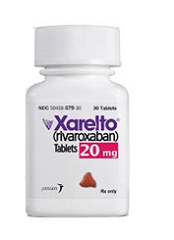
ORLANDO, FL—“Real-world” data appear to confirm phase 3 results with rivaroxaban in patients who have deep vein thrombosis (DVT), with or without concomitant pulmonary embolism (PE).
Results of the phase 4 XALIA study suggest that, in clinical practice, the rates of major bleeding and recurrent venous thromboembolism (VTE) in patients taking rivaroxaban are generally consistent with results of the phase 3 EINSTEIN-DVT study.
Investigators noted, however, that methodological and other differences between the studies limit the ability to directly compare results of XALIA and EINSTEIN-DVT.
Alexander G. G. Turpie, MD, of McMaster University and Hamilton Health Sciences in Hamilton, Ontario, Canada, and his colleagues reported data from the XALIA study at the 2015 ASH Annual Meeting (abstract 894) and in The Lancet Haematology.
The study was sponsored by Janssen and Bayer HealthCare.
“The real-world insights from XALIA confirm the positive benefit-risk profile of rivaroxaban for the treatment of deep vein thrombosis that was observed in the phase 3 EINSTEIN-DVT study, signaling that the medicine is performing as expected in patients that physicians typically see in everyday clinical practice,” Dr Turpie said.
Study design
For the XALIA study, investigators compared once-daily rivaroxaban to standard anticoagulation in patients with DVT, with or without concomitant PE. Standard anticoagulation was considered initial treatment with heparin, low-molecular-weight heparin, or fondaparinux, typically overlapping with and followed by warfarin.
The study enrolled 5142 patients age 18 and older. Patients were enrolled between June 2012 and March 2014 and followed for at least 12 months.
A total of 4768 patients were included in the primary analysis—2619 in the rivaroxaban group and 2149 in the standard anticoagulation group.
But the investigators also completed a propensity-score analysis to address differences in baseline characteristics and help correct for any selection bias. There were 4515 patients in this analysis—2505 in the rivaroxaban group and 2010 in the standard anticoagulation group.
The primary outcomes were major bleeding, recurrent VTE, and all-cause mortality.
Results
In the propensity score-adjusted population, major bleeding occurred in 0.8% of patients receiving rivaroxaban and 2.1% of those receiving standard anticoagulation (hazard ratio[HR]=0.77, P=0.44).
There were no fatal bleeding events in the rivaroxaban group and 2 fatal bleeding events in the standard anticoagulation group.
In EINSTEIN-DVT, major bleeding occurred in 0.8% of patients taking rivaroxaban, and there was 1 fatal bleeding event.
In XALIA (propensity score-adjusted population), VTE recurred in 1.4% of patients receiving rivaroxaban and 2.3% of those receiving standard anticoagulation (HR=0.91, P=0.72).
In EINSTEIN-DVT, VTE recurred in 2.1% of patients taking rivaroxaban.
In XALIA (propensity score-adjusted population), the rate of all-cause mortality was 0.4% in patients taking rivaroxaban and 3.4% in those receiving standard anticoagulation (HR=0.51, P=0.07).
In EINSTEIN-DVT, the rate of all-cause mortality was 2.2% in patients taking rivaroxaban.


